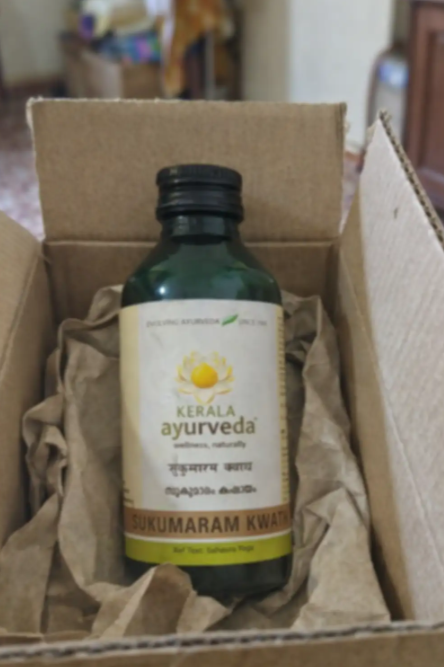Key Benefits of Kerala Ayurveda Sukumaram Kwath
- Supports relief from menstrual discomfort and cramps
- Helps ease irregular and delayed periods, promoting cycle regularity
- Alleviates bloating, indigestion and flatulence with gentle digestive support
- Soothes prolonged menstrual bleeding by balancing natural flow
- Aids in restoring uterine health and revitalizing reproductive tissues
- Balances the three doshas, with special emphasis on pacifying aggravated Vata
- Replenishes blood iron and nutrients lost during menstruation
Product Description of Kerala Ayurveda Sukumaram Kwath
Kerala Ayurveda Sukumaram Kwath is a traditional herbal decoction crafted for women’s wellness. It gently works with your body’s natural rhythm—there’s something almost poetic in how it unfolds. This kwath has been used for generations to ease the tensions of menstral cycles, soothe digestive woes and bring harmony to the gynecological system. The aroma is mildly sweet, with earthy herb notes that linger softly.
Unlike one-note remedies, Sukumaram Kwath offers a multipronged approach: it supports healthy uterine function, it calms the gut, and restores balance to Vata-predominant imbalances—though it doesn’t scream “miracle worker”—it’s more like a wise friend reminding you “take a deep breath, all will be well.” Some days you’ll prefer it warm as a comforting cup of tea; other times chilled, almost like a refreshing tonic.
Users often report a subtle ease in PMS tension after a week or two of regular use. You might notice less bloating or that nagging lower-back ache softens, without drowsiness. And because it’s free from caffeine and synthetic additives, you can sip day or night—just listen to your body. A small note: if you’re new to kwaths, the taste may take a moment to love, but many say it grows on them. In short, Sukumaram Kwath is a humble ally in the journey toward balanced cycles and digestive comfort.
Key ingredients with descriptions of Kerala Ayurveda Sukumaram Kwath
- Asparagus racemosus (Shatavari): Traditionally known to support reproductive health and nourish feminine tissues.
- Desmostachya bipinnata (Kusha/Thatch grass): Traditionally used as a cooling herb to pacify Pitta dosha and soothe excessive bleeding.
- Boerhavia diffusa (Punarnava/Hogweed): Traditionally valued for maintaining fluid balance and supporting normal menstrual flow.
- Ricinus communis (Eranda/Castor plant): Traditionally employed to support uterine cell renewal and gentle detoxification.
- Vitis vinifera (Draksha/Raisins): Traditionally used to replenish iron and nourish the bloodstream.
Key uses of Kerala Ayurveda Sukumaram Kwath
- PMS and menstrual cramps: take daily or during cycle to reduce discomfort.
- Irregular menstruation: helps bring delayed or scanty periods towards normality.
- Heavy or prolonged bleeding: supports healthy flow and uterine tone.
- Indigestion and bloating: use as a digestive tonic after meals.
- Flatulence and gas: calms Vata-related gut disturbances.
- Postnatal recovery: aids in restoring strength and uterine health.
How to use Kerala Ayurveda Sukumaram Kwath
Boil 1 teaspoon (about 3g) of Sukumaram Kwath powder in 2 cups of water until reduced to one cup. Strain and drink warm, twice daily—preferably after meals. For best results, continue use for 2–3 menstrual cycles or as advised by an Ayurvedic practitioner.
Safety information about Kerala Ayurveda Sukumaram Kwath
Children: Not recommended for children under 12 without professional guidance.
Pregnant women: Consult your healthcare provider before use, especially in first trimester.
Breastfeeding mothers: Generally considered safe but seek medical advice if unsure.
People with chronic diseases: Check with your doctor if you have liver, kidney, or hormonal disorders.
People with allergies: Contains botanicals—discontinue if hypersensitivity or rash occurs.
Elderly individuals: Start with a smaller dose to assess tolerance; monitor blood pressure if sensitive.
Patients taking medications: May interact with blood thinners or hormone therapies—consult your physician.
People with weakened immunity: Use cautiously; discuss with a healthcare professional before starting any new herbal regimen.
Additional information about Kerala Ayurveda Sukumaram Kwath
Storage: Keep the product in a cool, dry place, away from direct sunlight. Always use a dry spoon to scoop the powder to prevent moisture ingress. Shelf Life: 24 months from manufacturing date. Packaging: Sealed in a food-grade pouch to maintain freshness and aroma. Compliance: Manufactured under GMP guidelines. Note: Individual results may vary; this product is not intended to diagnose, treat, cure, or prevent any disease.
